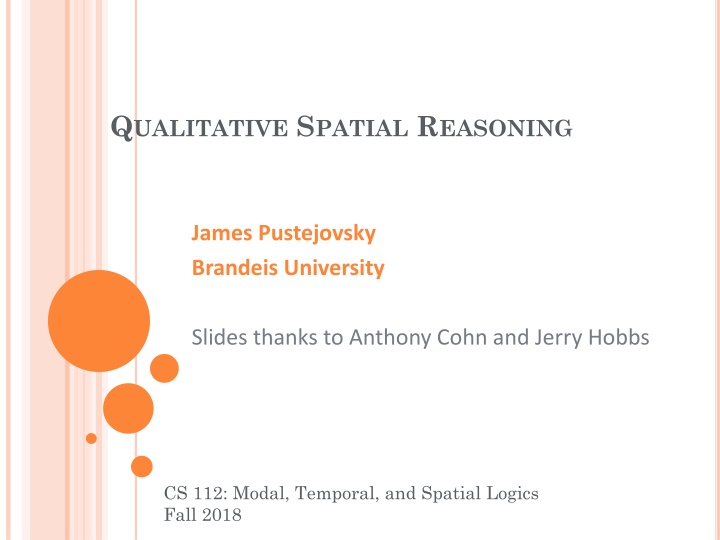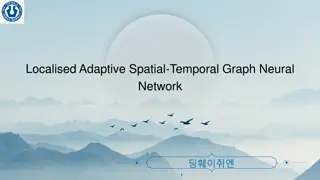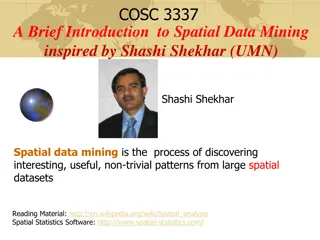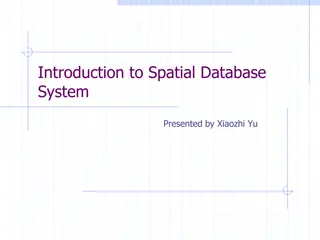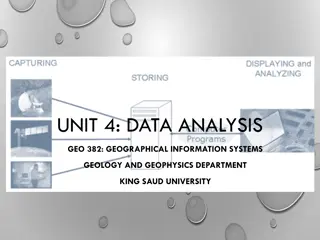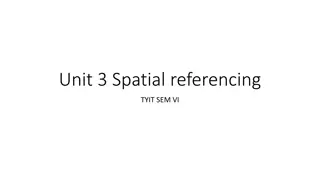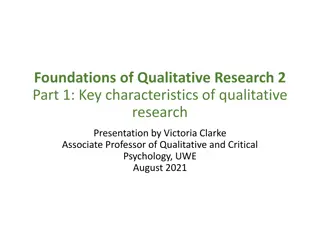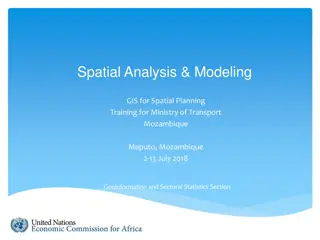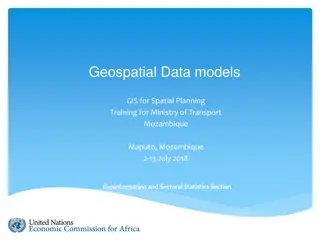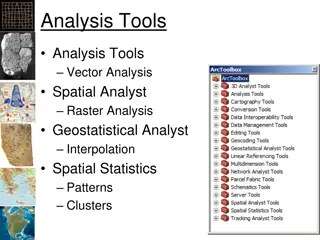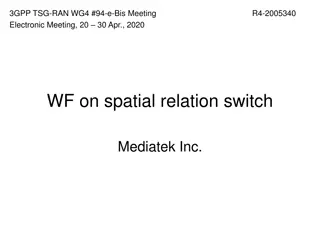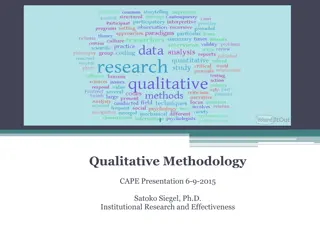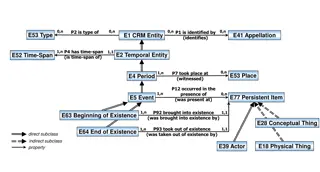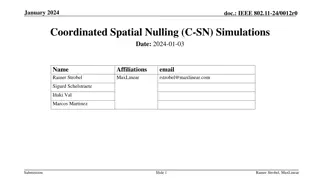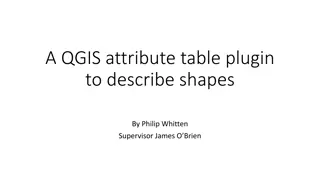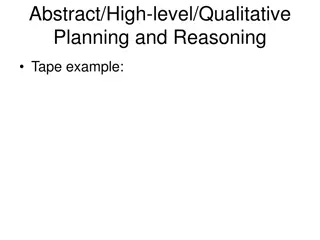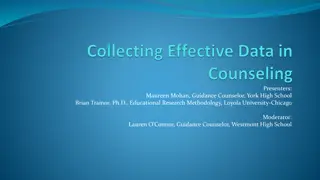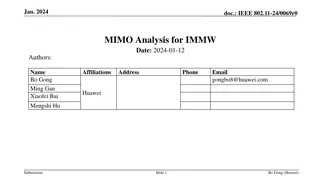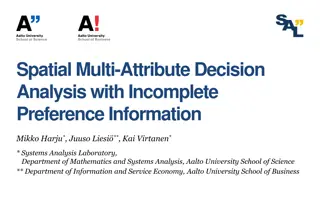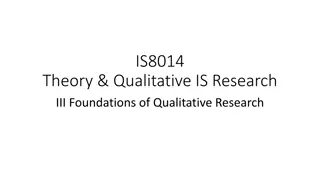QUALITATIVE SPATIAL REASONING
Qualitative spatial reasoning, including aspects of ontology, topology, orientation, distance, and shape. Delve into reasoning about geographic change and the ontology of space, discussing extended entities, embedding space, and why regions play a crucial role. Discover the fundamentals of topology, boundaries, closure, and exterior in spatial reasoning.
Download Presentation

Please find below an Image/Link to download the presentation.
The content on the website is provided AS IS for your information and personal use only. It may not be sold, licensed, or shared on other websites without obtaining consent from the author.If you encounter any issues during the download, it is possible that the publisher has removed the file from their server.
You are allowed to download the files provided on this website for personal or commercial use, subject to the condition that they are used lawfully. All files are the property of their respective owners.
The content on the website is provided AS IS for your information and personal use only. It may not be sold, licensed, or shared on other websites without obtaining consent from the author.
E N D
Presentation Transcript
QUALITATIVE SPATIAL REASONING James Pustejovsky Brandeis University Slides thanks to Anthony Cohn and Jerry Hobbs CS 112: Modal, Temporal, and Spatial Logics Fall 2018
QUALITATIVE SPATIAL REASONING Many aspects: ontology, topology, orientation, distance, shape... spatial change uncertainty reasoning mechanisms pure space v. domain dependent
QUALITATIVE SPATIAL REASONING Traditional QR spatially very inexpressive Applications in: Natural Language Understanding GIS Visual Languages Biological systems Robotics Multi Modal interfaces Event recognition from video input Spatial analogies ...
REASONINGABOUT GEOGRAPHICCHANGE Consider the change in the topology of Europe s political boundaries and the topological relationships between countries disconnected countries countries surrounding others Did France ever enclose Switzerland? (Yes, in 1809.5) continuous and discontinuous change
ONTOLOGYOF SPACE extended entities (regions)? points, lines, boundaries? mixed dimension entities? What is the embedding space? connected? discrete? dense? dimension? Euclidean?... What entities and relations do we take as primitive, and what are defined from these primitives?
WHYREGIONS? encodes indefiniteness naturally space occupied by physical bodies a sharp pencil point still draws a line of finite thickness! points can be reconstructed from regions if desired as infinite nests of regions unintuitive that extended regions can be composed entirely of dimensionless points occupying no space! However: lines/points may still be useful abstractions
TOPOLOGY Fundamental aspect of space rubber sheet geometry connectivity, holes, dimension interior: i(X) union of all open sets contained in X i(X) X i(i(X)) = i(X) i(U) = U i(X Y) = i(X) i(Y) Universe, U is an open set
BOUNDARY, CLOSURE, EXTERIOR Closure of X: intersection of all closed sets containing X Complement of X: all points not in X Exterior of X: interior of complement of X Boundary of X: closure of X closure of exterior of X
HISTORYOF QSR (1) Little on QSR in AI until late 80s some work in QR E.g. FROB (Forbus) bouncing balls (point masses) can they collide? place vocabulary: direction + topology
HISTORYOF QSR (2) Work in philosophical logic Whitehead(20): Concept of Nature defining points from regions (extensive abstraction) Nicod(24): intrinsic/extrinsic complexity Analysis of temporal relations (cf. Allen(83)!) de Laguna(22): x can connect y and z Whitehead(29): revised theory binary connection relation between regions
HISTORYOF QSR (3) Mereology: formal theory of part-whole relation Lesniewski(27-31) Tarski (35) Leonard & Goodman(40) Simons(87)
HISTORYOF QSR (4) Tarski s Geometry of Solids (29) mereology + sphere(x) made categorical indirectly: points defined as nested spheres defined equidistance and betweeness obeying axioms of Euclidean geometry reasoning ultimately depends on reasoning in elementary geometry decidable but not tractable
HISTORYOF QSR (5) Clarke(81,85): attempt to construct system more expressive than mereology simpler than Tarski s based on binary connection relation (Whitehead 29) C(x,y) x,y [C(x,y) C(y,x)] z C(z,z) spatial or spatio-temporal interpretation intended interpretation of C(x,y) : x & y share a point
HISTORYOF QSR (6) topological functions: interior(x), closure(x) quasi-Boolean functions: sum(x,y), diff(x,y), prod(x,y), compl(x,y) quasi because no null region Defines many relations and proves properties of theory
RCC THEORY Randell & Cohn (89) based closely on Clarke Randell et al (92) reinterprets C(x,y): don t distinguish open/closed regions same area physical objects naturally interpreted as closed regions break stick in half: where does dividing surface end up? closures of x and y share a point distance between x and y is 0
DEFININGRELATIONSUSING C(X,Y) (1) DC(x,y) df C(x,y) x and y are disconnected P(x,y) df z [C(x,z) C(y,z)] x is a part of y PP(x,y) df P(x,y) P(y,x) x is a proper part of y EQ(x,y) df P(x,y) P(y,x) x and y are equal alternatively, an axiom if equality built in
DEFININGRELATIONSUSING C(X,Y) (2) O(x,y) df z[P(z,x) P(z,y)] x and y overlap DR(x,y) df O(x,y) x and y are discrete PO(x,y) df O(x,y) P(x,y) P(y,x) x and y partially overlap
DEFININGRELATIONSUSING C(X,Y) (3) EC(x,y) df C(x,y) O(x,y) x and y externally connect TPP(x,y) df PP(x,y) z[EC(z,y) EC(z,x)] x is a tangential proper part of y NTPP(x,y) df PP(x,y) TPP(x,y) x is a non tangential proper part of y
RCC-8 8 provably jointly exhaustive pairwise disjoint relations (JEPD) DC EC PO TPP NTPP EQ TPPi NTPPi
EXPRESSIVENESSSOF C(X,Y) Can construct formulae to distinguish many different situations connectedness holes dimension
NOTIONSOFCONNECTEDNESS One piece Interior connected Well connected
OTHERRELATIONSHIPSDEFINABLE FROM C(X,Y) E.g. FTPP(x,y) x is a firm tangential part of y Intrinsic TPP: ITPP(x) TPP(x,y) definition requires externally connecting z universe can have an ITPP but not a TPP
4-INTERSECTION (4IM) EGENHOFER & FRANZOSA (91) boundary(x) boundary(y) interior(y) interior(x) 24 = 16 combinations 8 relations assuming planar regular point sets disjoint overlap in coveredby touch cover equal contains
EXTENSIONTOCOVERREGIONS WITHHOLES Egenhofer(94) Describe relationship using 4-intersection between: x and y x and each hole of y y and each hole of x each hole of x and each hole of y
9-INTERSECTIONMODEL (9IM) boundary(y) boundary(x) interior(y) exterior(x) interior(x) exterior(x) 29 = 512 combinations 8 relations assuming planar regular point sets potentially more expressive considers relationship between region and embedding space
9-INTERSECTION MODELFOR LINE-REGION RELATIONS EGENHOFERAND HERRING (1991)
DIRECTION-RELATION MATRIX (GOYAL & SHARMA 97) cardinal directions for extended spatial objects 0 0 0 1 1 0 1 1 0 also fine granularity version with decimal fractions giving percentage of target object in partition
C(X,Y): 3 DIMENSIONSOFVARIATION Closed or open C1(x, y) x y C2(x, y) x c(y) orc(x) y C3(x, y) c(x) c(y) Firmness of connection point, surface, complete boundary Degree of connection between multipiece regions All/some components of x are connected to all/some components of y
First two dimensions of variation C C C minimal connection Ca x x x y y y extended connection Cb x x x y y y maximal connection Cc x x x y y y Cd perfect connection x x x y y y Cf RCC8 and conceptual neighbourhoods
ALGEBRAIC TOPOLOGY Alternative approach to topology based on cell complexes rather than point sets - Lienhardt(91), Brisson (93) Applications in GIS, e.g. Frank & Kuhn (86), Pigot (92,94) CAD, e.g. Ferrucci (91) Vision, e.g. Faugeras , Bras-Mehlman & Boissonnat (90)
EXPRESSIVENESSOFTOPOLOGY can define many further relations characterising properties of and between regions e.g. modes of overlap of 2D regions (Galton 98) 2x2 matrix which counts number of connected components of AB, A\B, B\A, compl(AB) could also count number of intersections/touchings but is this qualitative?
POSITIONVIATOPOLOGY (BITTNER 97) fixed background partition of space e.g. states of the USA describe position of object by topological relations w.r.t. background partition ternary relation between 2 internally connected background regions well-connected along single boundary segment and an arbitrary figure region consider whether there could exist r1,r2,r3,r4 P or DC to figure region r3 r1 15 possible relations e.g. <r1:+P,r2:+DC,r3:-P,r4:-P> r2 r4
KINDSOFSPATIALCHANGE (1) Topological changes in single spatial entity: change in dimension usually by abstraction/granularity shift e.g. road: 1D 2D 3D change in number of topological components e.g. breaking a cup, fusing blobs of mercury change in number of tunnels e.g. drilling through a block of wood change in number of interior cavities e.g. putting lid on container
KINDSOFSPATIALCHANGE (2) Topological changes between spatial entities: e.g. change of RCC/4IM/9IM/ relation change in position, size, shape, orientation, granularity may cause topological change
CONTINUITY NETWORKS/CONCEPTUAL NEIGHBORHOODS What are next qualitative relations if entities transform/translate continuously? E.g. RCC-8 If uncertain about the relation what are the next most likely possibilities? Uncertainty of precise relation will result in connected subgraph (Freksa 91)
SPECIALISINGTHECONTINUITYNETWORK can delete links given certain constraints e.g. no size change (c.f. Freksa s specialisation of temporal CN)
QUALITATIVESIMULATION (CUIETAL 92) Can be used as basis of qualitative simulation algorithm initial state set of ground atoms (facts) generate possible successors for each fact form cross product apply any user defined add/delete rules filter using user defined rules check each new state (cross product element) for consistency (using composition table)
CONCEPTUAL NEIGHBORHOODSFOR OTHERCALCULI Virtually every calculus with a set of JEPD relations has presented a CN. E.g.
A LINGUISTICASIDE Spatial prepositions in natural language seem to display a conceptual neighbourhood structure. E.g. consider: put cup on table bandaid on leg picture on wall handle on door apple on twig apple in bowl Different languages group these in different ways but always observing a linear conceptual neighbourhood (Bowerman 97)
CLOSESTTOPOLOGICALDISTANCE (EGENHOFER & AL-TAHA 92) For each 4-IM (or 9-IM) matrix, determine which matrices are closest (fewest entries changed) Closely related to notion of conceptual neighbourhood 3 missing links!
MODELLINGSPATIALPROCESSES (EGENHOFER & AL-TAHA 92) Identify traversals of CN with spatial processes E.g. expanding x Other patterns: reducing in size, rotation, translation
GALTONS (95) ANALYSISOFSPATIAL CHANGE Given underlying semantics, can generate continuity networks automatically for a class of relations which may hold at different times Moreover, can determine which relations dominate each other R1 dominates R2 if R2 can hold over interval followed/preceded by R1 instantaneously E.g. RCC8
USINGDOMINANCETODISAMBIGUATETEMPORAL ORDER Consider simple CN will predict ambiguous immediate future dominance will forbid dotted arrow states of position v. states of motion c.f. QR s equality change law
SPATIAL CHANGEAS SPATIOTEMPORAL HISTORIES (1) (MULLER 98) Hayes proposed idea in Na ve Physics Manifesto (See also: Russell(14), Carnap(58)) C(x,y) true iff the n-D spatio-temporal regions x,y share a point (Clark connection) x < y true if spatio-temporal region x is temporally before y x<>y true iff the n-D spatio-temporal regions x,y are temporally connected axiomatised la Asher/Vieu(95)
